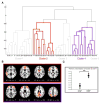Creative Cognition and Brain Network Dynamics
- PMID: 26553223
- PMCID: PMC4724474
- DOI: 10.1016/j.tics.2015.10.004
Creative Cognition and Brain Network Dynamics
Abstract
Creative thinking is central to the arts, sciences, and everyday life. How does the brain produce creative thought? A series of recently published papers has begun to provide insight into this question, reporting a strikingly similar pattern of brain activity and connectivity across a range of creative tasks and domains, from divergent thinking to poetry composition to musical improvisation. This research suggests that creative thought involves dynamic interactions of large-scale brain systems, with the most compelling finding being that the default and executive control networks, which can show an antagonistic relation, tend to cooperate during creative cognition and artistic performance. These findings have implications for understanding how brain networks interact to support complex cognitive processes, particularly those involving goal-directed, self-generated thought.
Keywords: connectivity; creativity; expertise; imagination; improvisation; networks.
Copyright © 2015 Elsevier Ltd. All rights reserved.
Figures



References
-
- Barron F. The disposition toward originality. J Abnorm Soc Psych. 1955;51:478–485. - PubMed
-
- Runco MA, Jaeger GJ. The standard definition of creativity. Creat Res J. 24:92–96.
-
- Diedrich J, et al. Are creative ideas novel and useful? Psychol Aesthet Crea Arts. 2015;9:35–40.
-
- Smallwood J. Distinguishes how from why the mind wanders: A process-occurrence framework for self-generated mental activity. Psychol Bull. 2014;139:519–535. - PubMed
Publication types
MeSH terms
Grants and funding
LinkOut - more resources
Full Text Sources
Other Literature Sources

